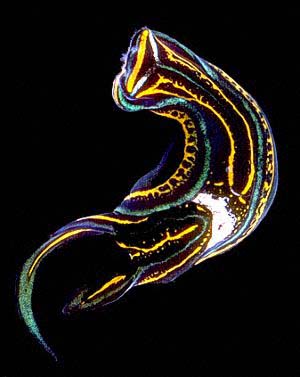
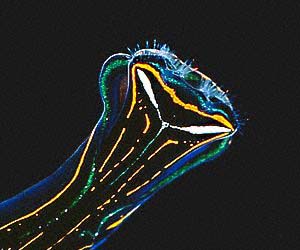
Chelidonura hirundinina
(Quoy & Gaimard, 1832)
Order: CEPHALASPIDEA
Family: Aglajidae
DISTRIBUTION
Tropical Indo-West Pacific, Caribbean.
PHOTO
Lower photo showing the prominent sensory bristles around the mouth. Animal 25mm long alive.
Long Reef, Sydney, New South Wales, Australia. PHOTOS: John Fields.
Species of Chelidonura are characterised by the pair of tapering "tails", (the genus name referring to the chela-like tails), and the mounds of sensory bristles on either side of the mouth. Sensory bristles are present in all aglajids, but they are most prominent in Chelidonura. Until a few weeks ago the food of Chelidonura was a mystery but thanks to participants to the Slug Forum we now know they feed on flatworms. (See correspondence on the Chelidonura varians page. While some species of Chelidonura seldom grow larger than 10mm, other species reach up to 90mm. Chelidonura hirundinina usually does not exceed 40mm, but is often much smaller.
A very similarly coloured species, Chelidonura philinopsis, may be just a colour form.
References:
• Redfern. C., 2001 Bahamian Seashells: a Thousand Species from Abaco, Bahamas.
• Rudman,W.B., 1974. A comparison of Chelidonura, Navanax and Aglaja with other genera of the Aglajidae. Zoological Journal of the Linnean Society, 54: 185-212.
• Rudman,W.B. 1973. On some species of Chelidonura (Opisthobranchia: Aglajidae) from Zanzibar and Fiji. Zoological Journal of the Linnean Society, 52: 201-215.
• Thompson, T.E. (1977) Jamaican opisthobranch molluscs I. Journal of Molluscan Studies, 43(2): 93-139, pls.1-3.
Rudman, W.B., 1998 (October 14) Chelidonura hirundinina (Quoy & Gaimard, 1832). [In] Sea Slug Forum. Australian Museum, Sydney. Available from http://www.seaslugforum.net/find/chelhiru
Related messages
Chelidonura hirundinina from U.S.Virgin Islands
September 6, 2007
From: Carly Kauffman
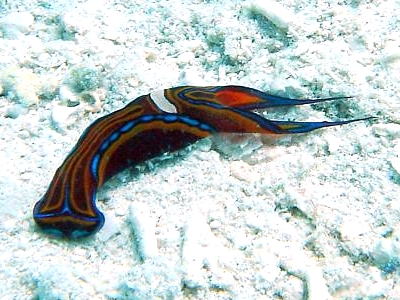
Dear Dr. Rudman,
This specimen was one of 6 that I saw at Maho Bay, St. John We are in the Atlantic Ocean very near to Puerto Rico. In a book I have by Paul Humann he says that they eat other head shield slugs. Does that mean they eat each other?
I really enjoyed seeing these with my friend Caroline! I had never observed this species before.
Locality: Maho Bay, St. John, 6 meters, U.S.Virgin Islands, Atlantic Ocean, 01 September 2007, sandy sea grass bed. Length: 3 1/2 cm. Photographer: Carly Kauffman.
Sincerely,
Carly Kauffman
epeedame@yahoo.com
Kauffman, C.M., 2007 (Sep 6) Chelidonura hirundinina from U.S.Virgin Islands. [Message in] Sea Slug Forum. Australian Museum, Sydney. Available from http://www.seaslugforum.net/find/20652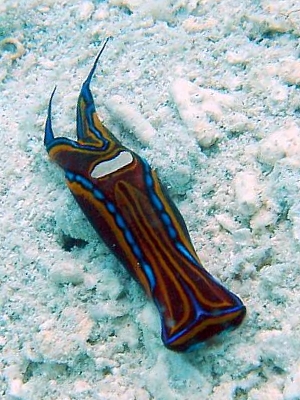
Dear Carly,
Yes this is a spectacularly coloured species. I'm not quite sure where Paul Humann got the information on them eating other head shield slugs or aglajids. If he has observed it himself that would be very interesting because as far as I know species of Chelidonura have only been observed eating small flatworms - many of which have split 'tails' which make them look like a small Chelidonura.
Many species of Chelidonura occur in large numbers for a short time and then disappear, so its not surprising you have never seen it before.
Best wishes,
Bill Rudman
Navanax inermis or Chelidonura hirundina ?
May 28, 2007
From: Takao Urasawa
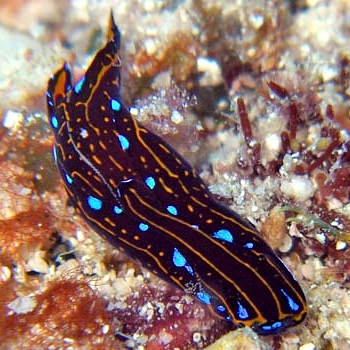
Concerning message #19140:
Dear Dr.Bill,
Here we have two pictures.
I thought first this animal is Chelidonura hirundina but it seems to look like Navanax inermis.
Locality: Crevasse of Wing Beach, 15m, Saipan, Northern Mariana Islands, Pacific Ocean, 14 May 2007, on the bedrock. Length: 10mm. Photographer: Takao Urasawa.
Moreover, we found eggs strings on this animal.
Would you tell us your idea, please ?
Best regards,
Ura
dswith@isletwind.com
Takao Urasawa, 2007 (May 28) Navanax inermis or Chelidonura hirundina ?. [Message in] Sea Slug Forum. Australian Museum, Sydney. Available from http://www.seaslugforum.net/find/19942
Dear Ura,
Although I haven't seen this colour form before I am pretty sure this is Chelidonura hirundina. It certainly looks a little like Navanax inermis, but the geographic distribution of that species seems to be restricted to the west coast of central America and up into southern California. Also, just in case it is a 'hitchhiker' the sides of its head are much more lobe-like in Navanax than in your animal.
Best wishes,
Bill Rudman
Unknown Chelidonura from New Zealand
May 24, 2007
From: Ian Skipworth
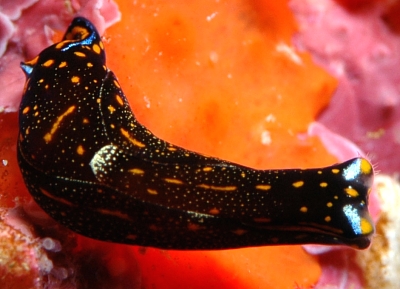
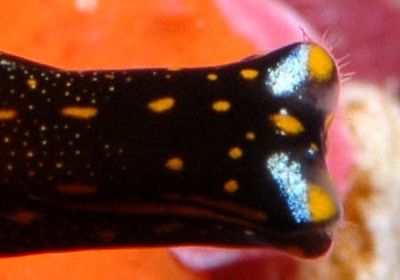
Hi Bill
Attached are a couple of snaps of an Aglajid slug which I found recently at
the Poor Knights. Any advice you can offer on its identification would be
much appreciated.
Details are as follows:
Locality: Poor Knights Islands, New Zealand, Pacific Ocean, Depth 15m, 12 May 2007, Rocky reef, Length 7 mm, Photographer Ian Skipworth
Cheers
Ian
ianskip@xtra.co.nz
Skipworth, I., 2007 (May 24) Unknown Chelidonura from New Zealand. [Message in] Sea Slug Forum. Australian Museum, Sydney. Available from http://www.seaslugforum.net/find/19932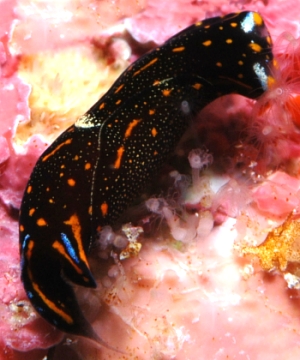
Dear Ian,
This is a useful find. When I first saw your photos I thought the white marks on the head were part of the white W-shaped mark on the head ofChelidonura fulvipunctata, but the blue and orange bands on the posterior 'tails' were a bit flamboyant for that species and then I realised it is probably a colour form ofChelidonura hirundinina. If you look at the species Fact Sheet you will see a photo of C. hirundinina in which the blue T on the head has white 'arms', which could be the origin of the two white marks on your specimen. Although C. hirundinina usually has orange longitudinal lines on its body, if you look at some of the photos of it on the Forum you will see examples where orange spots are present in the colour pattern. In fact your earlier message #16669 shows an animal from the Kermadecs with orange spots.
This may be a clue to interpreting some of the animals I have identified as Chelidonura sp. 2 and Chelidonura sp. 6
Best wishes,
Bill Rudman
Chelidonura hirundinina from the Kermadecs
May 26, 2006
From: Ian Skipworth

Hi Bill
Here's Chelidonura hirundinina from the Kermadecs. I guess it's another one of those slugs which seems a bit exotic for New Zealand waters but is probably quite common in the tropics.
Locality: Raoul Island, Kermadec Islands, 12 m, New Zealand, Pacific Ocean, 19 March 2006, Rocky reef. Length: 12 mm. Photographer: Ian Skipworth.
Cheers
Ian
ianskip@xtra.co.nz
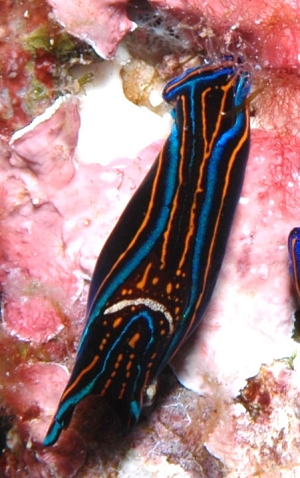
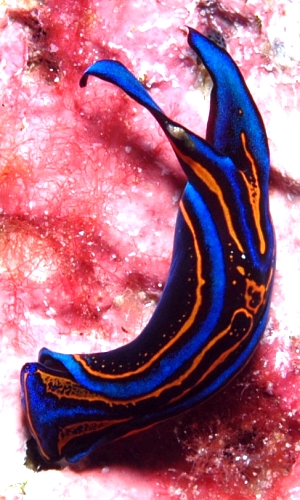
Dear Ian,
Yes this is indeed a tropical species found in both the Indo-West Pacific and the tropical west Atlantic. It certainly has not been reported from New Zealand 'proper' and as far as I can check it hasn't been reported from the Kermadecs either.
I have added close-ups of both your animals as they show to of the colour variants, the onr on the left simple lines, and the one on the right with spots as well, and the lines broadening into wider patchy bands. Such differences in early days were considered enough to make them different species.
Best wishes,
Bill Rudman
Chelidonura hirundinina from the Caribbean
October 18, 2005
From: Les Wilk
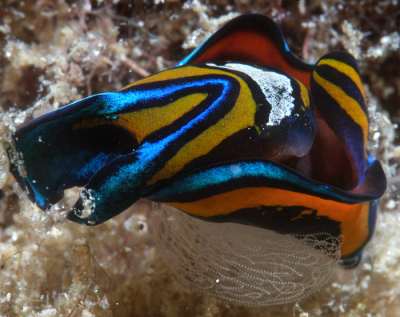
Hi Bill;
We took these photos in July 2005 off the west coast of the Caribbean island of St. Vincent. These slugs were abundant on several dive sites. Note the egg mass.
Locality: Critter Corner, St. Vincent, Caribbean Sea. Depth: 30 feet. Length: 0.75 inches. July 2005. Sand flat. Photographer: Keri Wilk
Les Wilk
wilk@reefnet.ca
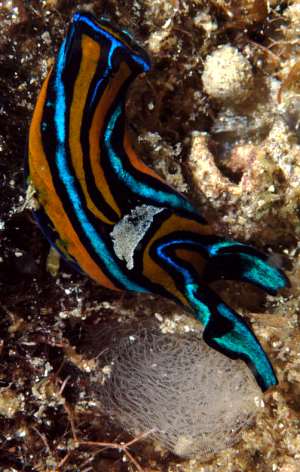
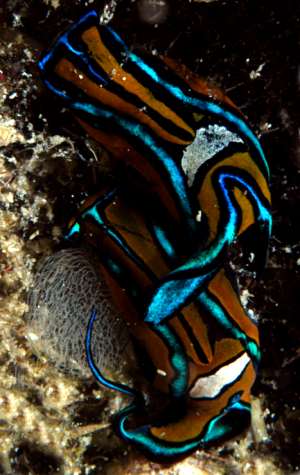
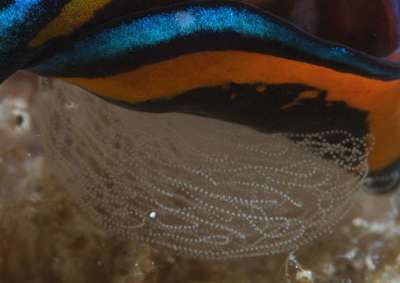
Dear Les,
It's nice to get photos of this species, as it is one of those that is found in both the warm water Atlantic and the Indo-West Pacific. Photos like this is one way of seeing if the two populations differ from each other in any way. As I often ask, photos showing animals 'doing things' - like laying eggs, is particularly interesting because we know so little about their basic biology. I look forward to further contributions
Best wishes,
Bill Rudman
Chelidonura hirundinina mating
August 26, 2005
From: Anne DuPont
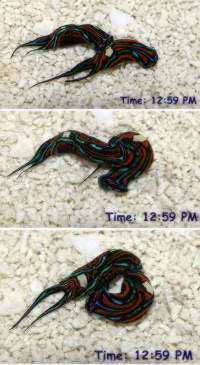
Dear Bill,
Here is a series of photos showing Chelidonura hirundinina mating. The encounter lasted 9 minutes. (with a digital camera now it is possible to know the exact moment a photo is taken)
These two C hirundinina were found crawling on sand during the day. The photos were taken January 28, 2005, depth appx 6 feet, at Stocking Island, Exumas, Bahamas.
Thank you again for the wonderful forum.
Cordially,
Anne DuPont
akdupont@bellsouth.net
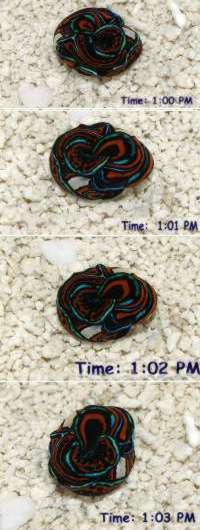
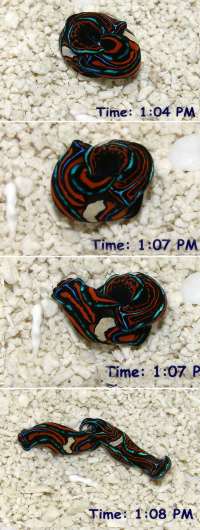
Dear Anne,
One of the reasons the Forum is wonderful is the wonderful contributions. Thanks for this great series of photos.
Best wishes,
Bill Rudman
Mating Chelidonura hirundinina from Hawaii
December 23, 2004
From: Lyudmila Zinkova

Dear Dr Rudman,
Thank you for your response on my sea hare question. I'd like to ask you another picture question, please. I saw dozens of mating sea slugs. I know they are hermaphrodite, which in my opinion means that the same kind should have the same color, yet the ones that were mating in Hawaii sometimes had a little bit different coloration. Here's one of the pictures. If you are interested I could send you much more of these.
Thank you.
Mila.
MBZ1@pge.com
Zinkova, L. , 2004 (Dec 23) Mating Chelidonura hirundinina from Hawaii. [Message in] Sea Slug Forum. Australian Museum, Sydney. Available from http://www.seaslugforum.net/find/12640Dear Mila,
Thanks for this photo of mating Chelidonura hirundinina. Hermaphrodite just means that they have a functioning set of both male and female reproductive organs. It doesn't mean they can't have the normal variability you expect to find in a species. Many species have some variation in their colour pattern, such as number of spots, size of spots etc. In Chelidonura hirundinina, as you'll see from other photos on the Forum, is quite variable in colour, especially in the shades of blue and yellow. You would only expect there to be no variation if two animals were identical twins (where a fertilised egg splits in two) or in clones, where off-spring are produced by budding off a bit of the parent's body (which certainly happens in some cnidarians, but not to my knowledge in molluscs).
Now that the Forum is active again, I would welcome more photos from Hawaii
Best wishes
Bill Rudman
Chelidonura hirundinina from Malaysia
September 17, 2003
From: Asther M. Lau
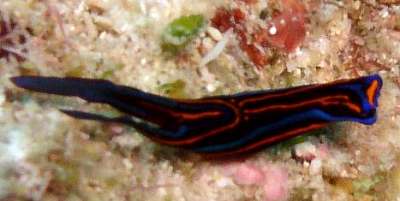
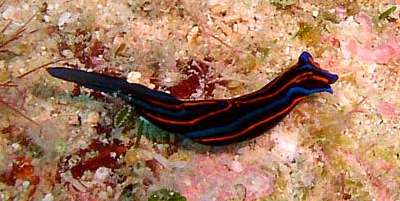
Dear Bill,
This beautiful thing caught my eyes with its bright orange stripe.
Please help identify.
Site: Crocodile Rock, Dayang Is. Malaysia
Date: May 17th, 2003
Size: 0.6 to 0.8 cm
Depth: 8 meter
Bottom Contour: Rocky with patches of sand
Thank you!
Asther M. Lau
diveworldwide@yahoo.com
Lau, A.M., 2003 (Sep 17) Chelidonura hirundinina from Malaysia. [Message in] Sea Slug Forum. Australian Museum, Sydney. Available from http://www.seaslugforum.net/find/10949Dear Asther,
This is a rather spectacularly bright colour form of Chelidonura hirundinina.
Best wishes
Bill Rudman
Chelidonura hirundinina from Caribbean
August 13, 2003
From: Carol Thomas
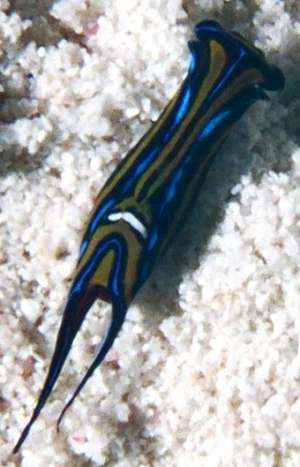
Could you please help me identify the attached animal. There were several of these creatures crawling slowly across this sandy area in Grand Turk and were about as long as a small finger nail. This shot was taken at about 50 feet. The divemaster pointed them out but said he had no idea what they were. Thanks for your help!
Carol Thomas
rooski11@insightbb.com
Thomas, C., 2003 (Aug 13) Chelidonura hirundinina from Caribbean. [Message in] Sea Slug Forum. Australian Museum, Sydney. Available from http://www.seaslugforum.net/find/10741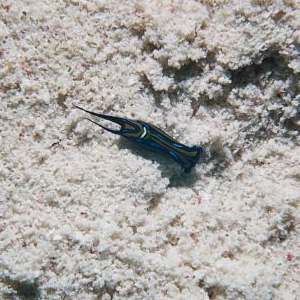
Dear Carole,
I guess the 'Grand Turk' your mention is one of the Turks and Caicos Islands, near the Bahamas, in the Caribbean. Your mystery animal is Chelidornura hirundinina, which is a sand-dwelling species feeding on small flatworms. It is found throughout the tropical Indo-West pacific and the Atlantic. This is the typical Caribbean colour form.
Best wishes,
Bill Rudman
Chelidonura hirundinina from the Bahamas
April 9, 2003
From: Anne DuPont
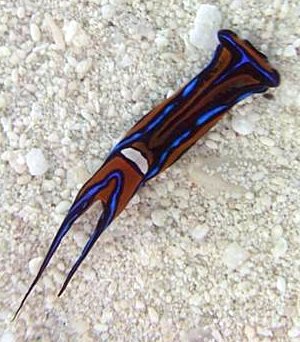
Bill,
To accompany my message about the Philinopsis, here is a photo of the Chelidonura hirundinina. A few were turquoise instead of the bright blue. I found them in sizes from 1/2 inch to a few large ones that were 1 and 1/2 inches long. They were all out in the day crawling on the sand, and I always found them with the Philinopsis sp.
Data: I found them over a range of 100 miles in the Southern Bahamas (The Exumas chain of islands) in depths from 2 feet to 10 feet. Jan - March 2003
Anne.
akdupont@bellsouth.net
DuPont, A., 2003 (Apr 9) Chelidonura hirundinina from the Bahamas. [Message in] Sea Slug Forum. Australian Museum, Sydney. Available from http://www.seaslugforum.net/find/9572Thanks Anne,
I used to think of this colour form as having an orange background colour, but what seems to have happened is that the orange bands of more 'normally' coloured specimens have expanded to almost completely replace the black background. This would seem to be the common Caribbean colour form.
• Redfern. C., 2001 Bahamian Seashells: a Thousand Species from Abaco, Bahamas.
• Thompson, T.E. (1977) Jamaican opisthobranch molluscs I. Journal of Molluscan Studies, 43(2): 93-139, pls.1-3.
Best wishes,
Bill Rudman
Chelidonura hirundinina from Lord Howe Island
January 6, 2003
From: W.B. Rudman
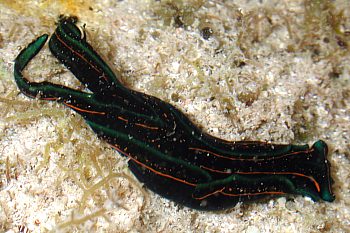
Here is a photo record from Ian Hutton of Chelidonura hirundinina from Lord Howe Island.
Location: Far Rocks
Bill Rudman
Rudman, W.B., 2003 (Jan 6) Chelidonura hirundinina from Lord Howe Island. [Message in] Sea Slug Forum. Australian Museum, Sydney. Available from http://www.seaslugforum.net/find/8777Chelidonura hirundinina from Bali
March 11, 2002
From: Stuart Hutchison
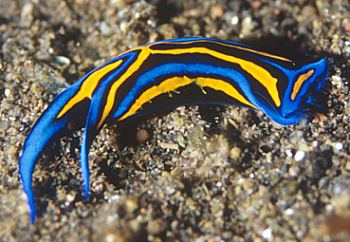
Hi Bill,
Here's Chelidonura hirundinina from Bali, Indonesia on 23 Oct 2001. Length 30mm. Depth 10m.
Regards,
Stuart
stuart@stuarthutchison.com.au
Hutchison, S., 2002 (Mar 11) Chelidonura hirundinina from Bali. [Message in] Sea Slug Forum. Australian Museum, Sydney. Available from http://www.seaslugforum.net/find/6304Thanks Stuart,
This species is quite variable in colour but I think this must be the most spectacular colour variety I have seen
Cheers,
Bill Rudman.
Chelidonura chelidonura from Fiji
February 9, 2002
From: Julian Sprung

Dear Bill,
I was recently in Fiji and I had a chance to observe and photograph the Chelidonura hirundinina-like species I had seen there 2 years ago. I suppose it is just a local variation of Chelidonura hirundinina , but it lacks the mid-body crescent shaped saddle stripe common to other color forms I've seen published.
I have attached some photographs of it and another species , similar to C. inornata, that occurred with it. Note the length of the tails in one photograph of the Chelidonura hirundinina-like species.
Both species occur together in abundance in shallow water on algae-covered rubble and sand. I believe they may hybridize in this situation, which may influence the coloration of each.
Sincerely,
Julian Sprung
julian@twolittlefishies.com
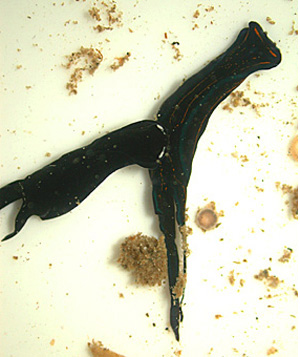
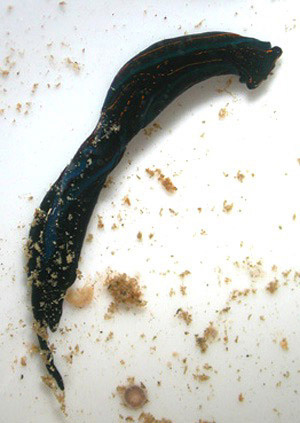
Dear Julian,
Thanks for these photos. Yes it is C. hirundinina which is quite variable in colour. As I discuss in your other message your other 'form' is indeed a distinct species. There is no evidence to suggest 'good' species do hybridise with other species. In fact the absence of hybridisation is usually taken as good evidence to show two animals are in fact different species.
Best wishes,
Bill Rudman
Chelidonura hirundinina in the Caribbean
October 18, 2001
From: Anne DuPont
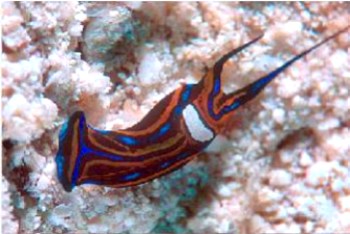
Hi Bill,
Recently I was diving in the Florida Keys (islands at the very tip of the eastern US) and two of my photographic buddies came up talking about a slug they saw with a square head and forked tail.
My dive buddies were Susan Mears, a still photographer [photofish@mindspring.com] and her husband Jim Mears who got video of the slug (Chelidonura hirundinina) with a black flatworm! Susan got an excellent photograph of the little guy which I have asked her to let me send to you after reading your page on Chelidonura hirundinina and saw that you were requesting pictures of the Caribbean form.
The date of Susan Mear's photo was September 8, 2001, and the location was in the Florida Keys, Florida, USA. The depth was 35 feet. We were diving a sandy area surounded by small patch reefs.
Best regards,
Anne DuPont
akdupont@bellsouth.net
DuPont, A., 2001 (Oct 18) Chelidonura hirundinina in the Caribbean. [Message in] Sea Slug Forum. Australian Museum, Sydney. Available from http://www.seaslugforum.net/find/5507Thanks Anne & Susan,
It's nice to see photos of these species which apparently have a circumtropical distribution in the Indian, Pacific and Atlantic Oceans. It suggests that despite millions of years of separation they still appear to look the same.
Best wishes,
Bill Rudman
Chelidonura hirundinina in the Solomons
September 24, 2001
From: Bruce Potter
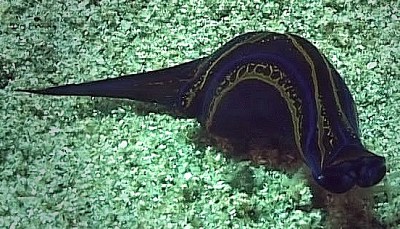
Dear Bill,
I was intrigued last Sunday to find a sand bank absolutely covered with very small Chelidonura's. Some were Chelidonura inornata and some were what I believe to be Chelidonura hirundinina. These were mainly about 5mm to 10mm long. There were dozens of each kind.
I found one slightly larger C.hirundinina, and as I have never seen it before I observed it for a while. It appeared to be actively hunting, and then I saw it attack a couple of what appeared to be very small flat worms. I have this all on video, and the worms are quite easy to see although very small, but I can't identify them. On the LOWER RIGHT photo you can see a small worm to the immediate right of the Chelidonura's head. In that it is only a frame taken from a video, it is not very distinct unfortunately.
This was in about 8 meters on the sandy slope beside the Bonegi 1 shipwreck just out of Honiara in the Solomon Islands. This particular slug was about 25mm long. [September, 2001].
Regards
Bruce Potter.
bruce.potter@adventist.org.sb
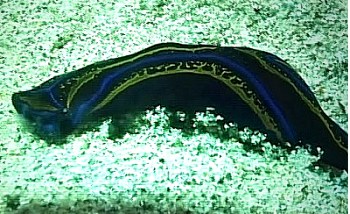
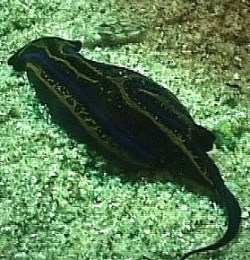
Dear Bruce,
It's nice to have another record of a feeding observation. Concerning the large populations of small animals you found. It seems this a common occurrence. I have often found large populations of small animals and then after a few weeks they have all gone. I assume what happens is that a swarm of larvae have to arrive in a suitable spot at the same time as a large population of small flatworms are in residence.
Cheers,
Bill Rudman.
Swallowtail sea slug?
September 24, 2001
From: Robin Adler
Hello:
Are you familiar with a sea slug called the "swallowtail sea slug"? I need to know its scientific name. I've been told it can be found in the Whitsunday area of the Great Barrier Reef.
Thanks,
Robin Adler
radler@ngs.org
Adler, R., 2001 (Sep 24) Swallowtail sea slug?. [Message in] Sea Slug Forum. Australian Museum, Sydney. Available from http://www.seaslugforum.net/find/3024Dear Robin,
The Swallow-tailed Sea Slug is Chelidonura hirundinina. Both Chelidonura (= claw-like tail) and hirundinina ( = swallow-like) refer to its forked 'tail'. You will find a Page with photos of this species on the Forum and if you go to the Species List you will find a list of species of Chelidonura (Family Aglajidae). If you look there you will find more on the biology of these fascinating carnivorous slugs. If you have specific questions, please don't hesitate to ask.
Best wishes,
Bill Rudman
Re: Chelidonura in Atlantic
September 21, 2001
From: Joe
Hi Ray,
I live in the U.K., and trying with no evail to get hold of this species, do you know of anyone who has them?, and if they would send them to the U.K.
Cheers,
Joe
shrimpan@lineone.net
Joe, 2001 (Sep 21) Re: Chelidonura in Atlantic. [Message in] Sea Slug Forum. Australian Museum, Sydney. Available from http://www.seaslugforum.net/find/4887Chelidonura in Atlantic
May 28, 2001
From: Ray
There is is picture of Chelidonura hirundinina in Paul Humann's Reef Creature ID book. Yet on this site you give its distribution as only the West Pacific. Does this species occur in the W. Atlantic?
It has a different coloration than the one pictured here. It has orange, black and blue stripes with a white patch on the mid back. Is this C. hirundinina?
Ray
P51MustNB@aol.com
ray, 2001 (May 28) Chelidonura in Atlantic. [Message in] Sea Slug Forum. Australian Museum, Sydney. Available from http://www.seaslugforum.net/find/4354Dear Ray,
In general the photo has the same T-shaped mark on the headshield as Indo-West Pacific specimens of the species but Humann's photo shows an orange rather than black background and lacks the yellow lines of Indo-West Pacific animals. The Caribbean fauna has lots of interesting links to the Indo-West Pacific such as Micromelo undata and Hydatina physis so there is insurmountable problem with Chelidonura hirundinina having a circumtropical distribution. Like many of these animals there is little published information on their anatomy and colour variability. Until we know more about the Caribbean animal I would prefer to remain undecided. I you have photos of the Caribbean animal they would be a welcome addition to the Forum.
I note that Humann gives Chelidonura hirundinina the common name Leech Headshield Slug which I guess was an attempt to appease the publisher's misguided belief that we can't survive without common names, even if they are manufactured artificially for the occasion. I presume Headshield Slugs comes from the Order Cephalaspidea, but Leech is clearly an error based on Hirudo = leech rather than the Hirundo = swallow. The scientific name of Chelidonura hirundinina certainly over-emphasises the shape of the 'tail' in these animals. Chelidonura is made up of chela (as in a crab's claw) and nura = tail. Also hirundinina = little swallow, which is another reference to the tail, so reminiscent of the bird's.
Best wishes,
Bill Rudman
Chelidonura hirundinina from Solomon Ids
February 7, 2001
From: Mary Jane Adams
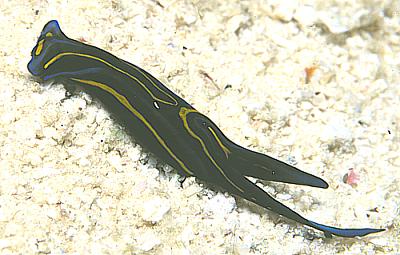
Hi Bill,
I found this slug on a sand slope on Anuha Island in the Florida Group, Solomon Ids in November, 2000. It was 25 mm long and 5 meters deep. Is this Chelidonura hirundinina? I frequently see P. varians on this divesite.
Thanks,
Mary Jane
divepng@yahoo.com
Adams, M.J., 2001 (Feb 7) Chelidonura hirundinina from Solomon Ids. [Message in] Sea Slug Forum. Australian Museum, Sydney. Available from http://www.seaslugforum.net/find/3664Dear Mary Jane,
Yes this is C. hirundinina.
Best wishes,
Bill Rudman
